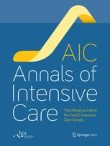Citation Impact 2023
Journal Impact Factor: 5.7
5-year Journal Impact Factor: 6.0
Source Normalized Impact per Paper (SNIP): 1.749
SCImago Journal Rank (SJR): 2.061
Speed 2023
Submission to first editorial decision (median days): 7
Submission to acceptance (median days): 91
Usage 2023
Downloads: 1,737,465
Altmetric mentions: 6,851
FGF-23 and PTH levels in patients with acute kidney injury: A cross-sectional case series study
Fibroblast growth factor-23 (FGF-23), a novel regulator of mineral metabolism, is markedly elevated in chronic kidney disease and has been associated with poor long-term outcomes. However, whether FGF-23 has a...
